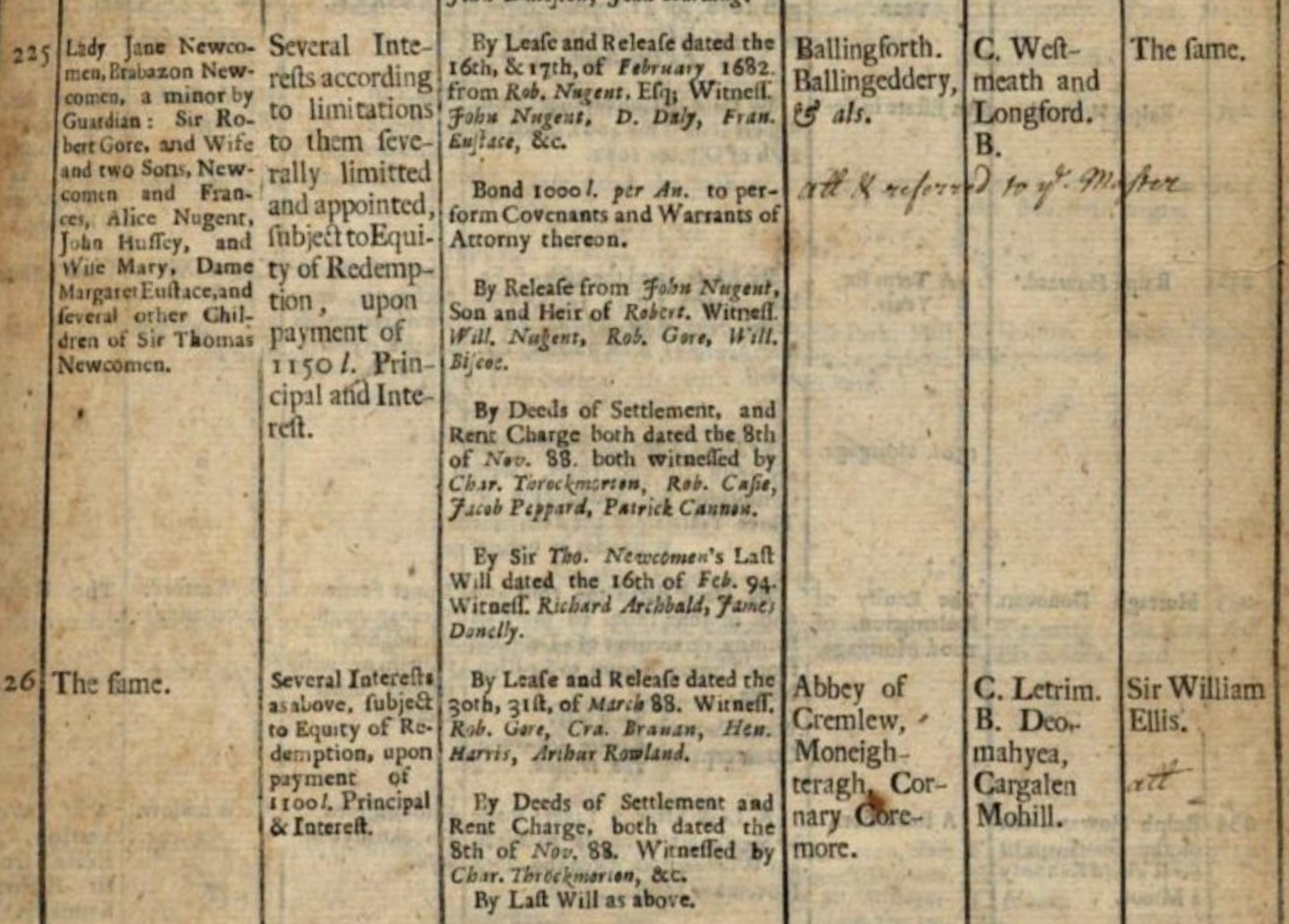***Content Warning: this post includes an historical account of domestic violence.
The legal sources underpinning Law versus Practice contain a large number of women’s names and provide relevant biographical information on them. By assigning a unique ID to every woman we add to the database, we can create distinct biographical profiles and uncover the networks and relationships that helped shape individual women’s lives. In doing so, we can trace the diverse contours of women’s lived experience in the early modern period.
One source that we are using is A list of claims entred [sic] with the trustees for the forfeited estates at Chichester House on College-Green, Dublin, on or before 10 August 1700. The trustees were appointed by the Act of Resumption of 1700. This legislation voided the ‘exorbitant’ grants of forfeited Jacobite land made by William III to his military generals and personal favourites. The List of claims is a printed schedule of the 3,140 claims adjudicated on by the trustees between 1700 and 1703.

Significantly, the Act of Resumption allowed claims to be submitted by any non-forfeiting person who held a legitimate title to a forfeited estate before the accession of William and Mary in February 1689. The retroactive nature of the Act and its extension to encumbered interests on freehold estates meant that a diverse body of property owners could enter claims. Conforming and nonconforming Protestants submitted claims alongside Catholics, with the nobility and gentry pursuing their interests alongside the ‘middling sorts.’ Over 700 claims involved female claimants or co-claimants, including married women, widows, spinsters, and minors, who were represented by a guardian. Many of those who submitted claims would have travelled to Dublin, to appear before the trustees at Chichester House, which was the old parliament building on College Green.

See: https://www.flickr.com/photos/britishlibrary/11151894495/
The List is a highly useful foundation for further research. An interesting example from our early research is Lady Jane Newcomen (née Brabazon). Jane, who was the daughter of Edward Brabazon and Rose (née Lambart), married Sir Thomas Newcomen of Sutton in 1688. The illegitimate son of Sir Beverley Newcomen and a woman named Niell, he was married first to Frances Talbot and together they had four daughters, namely Frances, Mary, Alice and Margaret.
Lady Jane Newcomen was named in two claims submitted to the trustees for the forfeited estates (numbers 225 and 226). She claimed with her son, Brabazon Newcomen, who was still a minor in 1700, and with Sir Thomas’s daughters from his first marriage. Frances joined the claim with her husband, Sir Robert Gore, and Mary likewise, with her husband, John Hussey. Alice claimed in her own right, as the widow of William Nugent, as did Margaret, who was the widow of Sir Maurice Eustace of Castle Martin in County Kildare. These joint claims – which were ultimately successful – concerned ‘several interests’ on lands in counties Westmeath, Longford and Leitrim, which were part of the forfeited estates of John Nugent and Sir William Ellis.

The List and the records of the trustees (which are now part of the Annesley Papers in PRONI), reveal much about the Newcomen family’s property ownership. They do not, however, shed much light on the relationships that underpinned this early modern blended family. Those insights are found elsewhere, in a letter that reveals a disturbing reality. In May 1694, Jane Newcomen wrote to the Bishop of Meath, Anthony Dopping, and disclosed that she was ‘still under ye same missery’ in her marriage. She then added that she had no ‘prospect of gaining quietness at home, hee since threatnes to break my neck and is so very violent that I am realy in danger of beeing injoured.’
Lady Newcomen’s letter to Dopping followed the bishop’s decision to award Sir Thomas’s daughter, Alice Nugent, some part of his estate. Lady Newcomen responded by telling Dopping that ‘if y[ou]r Lordship will not be pleased to bring him [Sir Thomas] to some better temperament [then] … I must beg y[ou]r Lordships pardon if I do not allowe ye award, it being my full resolution to part from him since he will be brought to nothing.’ She continued: ‘what can I do more than fly in silence from his fury…he has made mee so desperate.’
To make matters worse, Lady Newcomen did not enjoy a good relationship with Sir Thomas’s daughters from his first marriage to Frances Talbot. This may, in part, have been a consequence of her providing Sir Thomas with a male heir to the Newcomen estate; a development that, under the custom of primogeniture, would have deprived his four daughters of an equal-share inheritance. She informed Dopping that ‘I will never live with any of his daughters nor be trampled on any longer by them, neither will I be my own executioner.’1
The two claims entered by Lady Newcomen with Sir Thomas’s daughters in 1700 suggests that the family were united in securing their interests, but her earlier letter to Dopping describes a different and disturbing situation. Sir Thomas died in the summer of 1694 and it is possible that Lady Newcomen’s relationship with his daughters improved after that. It is more likely, however, that legal necessity made for otherwise estranged bedfellows at Chichester House in 1700.
- Armagh Robinson Library, Bishop Anthony Dopping Papers, KI/II/9 Volume 3 (1694-1733), Lady Jane Newcomen to Dopping, 22 May 1694. ↩︎


Leave a Reply